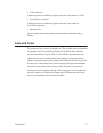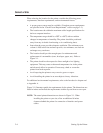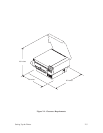
1–8
Introduction
General Laser Printer Technology
The operation of a laser printer is somewhat different than that of an impact
printer. They produce an entire page at once, compared to line printers, which
produce complete character lines.
NOTE: If the software application fails to give a form feed at the end of the
data, and the data does not exceed the selected lines per page
setting, the page will not print. Rather, it will remain in memory.
The laser printer has two basic functional parts: the engine and the controller.
The engine is responsible for the mechanical aspects of producing the page. The
controller controls the printer and is responsible for electronic data
manipulations.
NOTE: Laser printers can not print to the physical edge of the paper. If the
document image runs to the edge of the paper, portions of the image
may be lost.
The electrophotographic printing process, shown in Figure 1–2, consists of the
following steps:
1. Charging: The charge corona is a thin wire electrode that extends
across the width of the media. This electrode places a high–voltage
electrostatic charge on the organic photoconductor (OPC) drum.
2. Imaging: Based on data received from the host computer, a bit–mapped
image of the page is generated in random access memory (RAM) on the
controller (not shown).
3. Exposing: The laser scanning unit (LSU) exposes areas of the OPC
which are to be imaged (i.e., black). This forms a latent image of the
bit–mapped data. This image is made up of charged and uncharged
areas.
4. Developing: The latent image areas of the OPC attract toner from the
developer unit to form the developed image on the OPC drum. Since the
charged areas of the drum have the same charge as the toner, they repel
the toner.


















